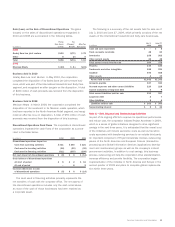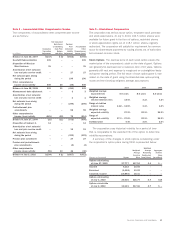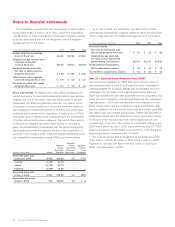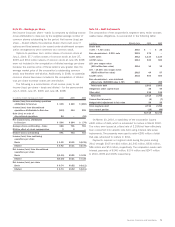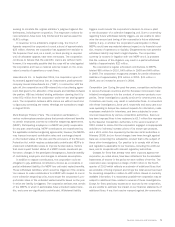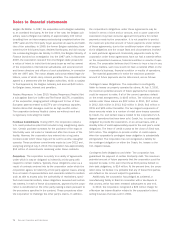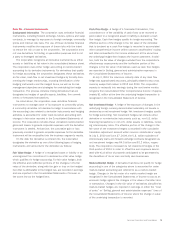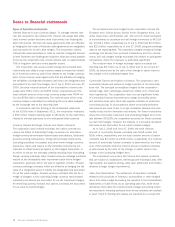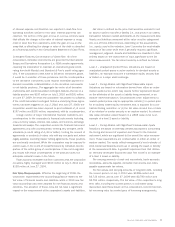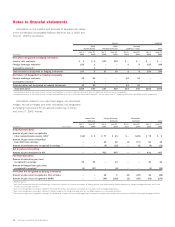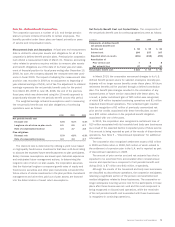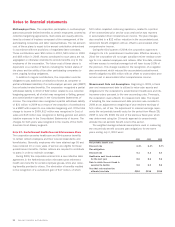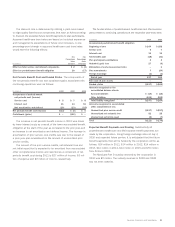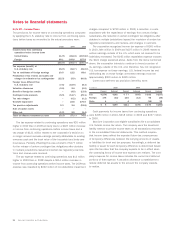Sara Lee 2010 Annual Report Download - page 77
Download and view the complete annual report
Please find page 77 of the 2010 Sara Lee annual report below. You can navigate through the pages in the report by either clicking on the pages listed below, or by using the keyword search tool below to find specific information within the annual report.Note 15 – Financial Instruments
Background Information The corporation uses derivative financial
instruments, including forward exchange, futures, options and swap
contracts, to manage its exposures to foreign exchange, commodity
prices and interest rate risks. The use of these derivative financial
instruments modifies the exposure of these risks with the intent
to reduce the risk or cost to the corporation. The corporation does
not use derivatives for trading or speculative purposes and is not
a party to leveraged derivatives.
The corporation recognizes all derivative instruments as either
assets or liabilities at fair value in the consolidated balance sheet.
The corporation uses either hedge accounting or mark-to-market
accounting for its derivative instruments. For derivatives that qualify
for hedge accounting, the corporation designates these derivatives
as fair value, cash flow or net investment hedges by formally docu-
menting the hedge relationships, including identification of the
hedging instruments and the hedged items, as well as its risk
management objectives and strategies for undertaking the hedge
transaction. The process includes linking derivatives that are
designated as hedges of specific assets, liabilities, firm commit-
ments or forecasted transactions.
As noted above, the corporation uses derivative financial
instruments to manage some of its exposure to commodity prices.
A commodity derivative not declared a hedge in accordance with
the accounting rules related to derivative instruments and hedging
activities is accounted for under mark-to-market accounting with
changes in fair value recorded in the Consolidated Statements of
Income. The corporation includes these unrealized mark-to-market
gains and losses in general corporate expenses until the derivative
instrument is settled. At that time, the cumulative gain or loss
previously recorded in general corporate expenses for the derivative
instrument will be reclassified into the business segment’s results.
On the date the derivative is entered into, the corporation
designates the derivative as one of the following types of hedging
instruments and accounts for the derivative as follows:
Fair Value Hedge A hedge of a recognized asset or liability or an
unrecognized firm commitment is declared as a fair value hedge
which qualifies for hedge accounting. For fair value hedges, both
the effective and ineffective portions of the changes in the fair
value of the derivative, along with the gain or loss on the hedged
item that is attributable to the hedged risk, are recorded in earnings
and are reported in the Consolidated Statements of Income on
the same line as the hedged item.
Cash Flow Hedge A hedge of a forecasted transaction, firm
commitment or of the variability of cash flows to be received or
paid related to a recognized asset or liability is declared a cash
flow hedge. Cash flow hedges qualify for hedge accounting. The
effective portion of the change in the fair value of the derivative
that is declared as a cash flow hedge is recorded in accumulated
other comprehensive income (within common stockholders’ equity)
and later reclassified to the income statement at the same time
the underlying hedged item impacts the income statement. In addi-
tion, both the fair value of changes excluded from the corporation’s
effectiveness assessments and the ineffective portion of the
changes in the fair value of derivatives used as cash flow hedges
are reported in Selling, general and administrative expenses in
the Consolidated Statements of Income.
At July 3, 2010 the maximum maturity date of any cash flow
hedge was approximately two years, principally related to two cross
currency swaps that mature in 2012 and 2013. The corporation
expects to reclassify into earnings during the next twelve months
net gains from Accumulated Other Comprehensive Income of approx-
imately $1 million at the time the underlying hedged transaction is
recognized in the Consolidated Statement of Income.
Net Investment Hedge A hedge of the exposure of changes in the
underlying foreign currency denominated subsidiary net assets is
declared as a net investment hedge. Net investment hedges qualify
for hedge accounting. Net investment hedges can include either
derivative or non-derivative instruments such as, non-U.S. dollar
financing transactions or non-U.S. dollar assets or liabilities, includ-
ing intercompany loans. The effective portion of the change in the
fair value of net investment hedges is recorded in the cumulative
translation adjustment account within common stockholders’ equity.
At July 3, 2010 and June 27, 2009, the U.S. dollar equivalent of
intercompany loans and forward exchange contracts designated as
net investment hedges was $4.5 billion and $3.2 billion, respec-
tively. The corporation increased its net investment hedges in the
third quarter of 2010 in order to offset the euro exposure associ-
ated with €1.6 billion of proceeds anticipated to be generated by
the divestiture of its air care and body care businesses.
Mark-to-Market Hedge A derivative that does not qualify for hedge
accounting in one of the categories above is accounted for under
mark-to-market accounting and referred to as a mark-to-market
hedge. Changes in the fair value of a mark-to-market hedge are
recognized in the Consolidated Statements of Income to act as an
economic hedge against the changes in the values of another item
or transaction. Changes in the fair value of derivatives classified as
mark-to-market hedges are reported in earnings in either the “Cost
of sales” or “Selling, general and administrative expenses” lines of
the Consolidated Statements of Income where the change in value
of the underlying transaction is recorded.
Sara Lee Corporation and Subsidiaries 75


